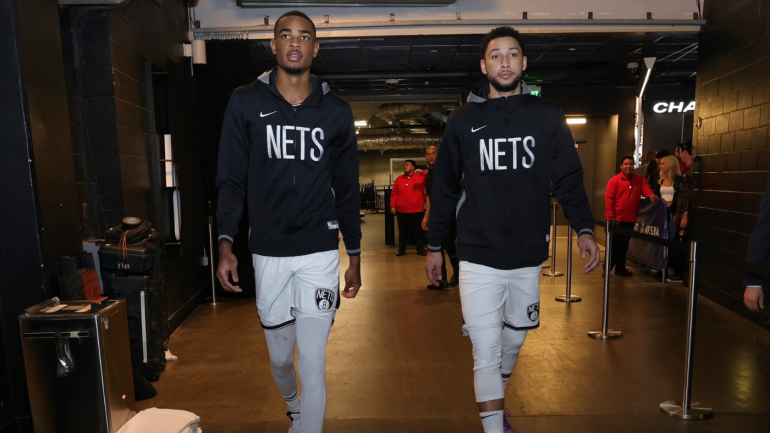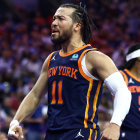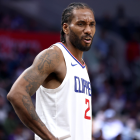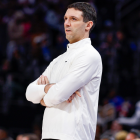
NEW YORK -- This time of year, it's not unusual to hear that a team like the Brooklyn Nets -- widely projected to finish in the middle of the pack -- is going to surprise people. When Nets coach Jacque Vaughn said it on Monday, though, he wasn't making a vague proclamation about their potential. Vaughn wants to literally surprise opponents.
In the fourth quarter of Brooklyn's preseason finale, the 6-foot-10 Ben Simmons brought the ball up on the right side of the court, then burst to his left and dropped it behind him for the 6-11 Nic Claxton, who was still several feet behind the 3-point line. Claxton zoomed downhill, hit his defender with a spin move and banked in a lefty layup in one fluid motion.
"I love plays like that because no one's working on guarding that," Vaughn said.
Given that neither Simmons nor Claxton is a jump shooter, it is notable that they are playing together at all, let alone confusing Miami Heat reserves with unconventional quick-hitters. Since the beginning of training camp, though, Vaughn has reiterated that he's more focused on their many strengths than their glaring weakness. That message isn't just for the media; he stopped a practice to deliver it to the team.
When Brooklyn opens the season Wednesday at Barclays Center, both Simmons and Claxton will be in the starting lineup. The Nets know that opponents are going to try to pack the paint against them, but they believe this oddball duo can work. It's a big bet, but it's best understood as a series of smaller ones.
Betting on skills and smarts
Non-shooters are not created equal. Case in point: If Brooklyn's starting center were Rudy Gobert, that play in Miami would never have been run.
Like Gobert, Claxton is a lob threat when he's rolling to the basket. But he's also a threat with the ball in his hands. He can attack slow-footed bigs off the bounce, make the right reads in the short roll and be a hub in the high post, where his fake handoffs can turn into uncontested dunks. He's not Zion Williamson, but the theory behind having him catch the ball with a runway to the rim is the same.
"We want Nic to put an extreme amount of pressure on the rim, whether that's vertical or whether that's with his speed," Vaughn said.
Claxton shot 78% at the rim last season, per Cleaning The Glass, and that's not just because he dunked a lot. He has always had the length to finish around rim protectors, and he has developed the strength to absorb contact from them.
"He's got great hands, he's got great touch," Simmons said. "We're going to figure it out. I think a little bit of time together on the floor where we're able to just compete and get to know each other on the floor is going to help."
At his best with the Philadelphia 76ers, Simmons was fairly adaptable despite his total lack of shooting gravity. Defenders choosing to back off of him risked letting him eat up that space and get all the way to the rim. He made timely cuts, was dangerous in the dunker spot and created countless kickout 3s. If the Nets get the aggressive, confident version of Simmons -- an enormous if, but the preseason was promising -- then they'll be able to use him in a variety of actions. They'll also be able to trust him to improvise.
This Ben 10 dime 🤯 pic.twitter.com/X9yM86ieH6
— Brooklyn Nets (@BrooklynNets) October 17, 2023
Simmons is responsible for one of the highlights of the preseason, non-Wembanyama division: a no-look, behind-the-back touch pass that led to a Spencer Dinwiddie corner 3. This is not the kind of thing that can be scripted, and Simmons might never make this exact read again, but he'll throw other passes that most players wouldn't try.
"I like to play with my instinct," Simmons said. "That's when I'm at my best. So for me to make a pass like that, it's simple: behind the back, wide-open corner 3."
All things equal, every team in the NBA would love to have five deadeye shooters on the floor at all times. Brooklyn does not have that luxury, but it does have a true basketball weirdo (complimentary) who is used to making creative plays in tight spaces.
Betting on defense leading to offense
Before a preseason game at Barclays, Sixers coach Nick Nurse repeatedly described the Nets as "an interesting team." He spoke of them as something of a curiosity, mentioning that they have "a lot of positionless guys" and "a lot of guys initiating offense." His team's biggest challenge, though, would be slowing them down.
"The pace is really up here in Brooklyn," Nurse said. "They're playing super fast, make or miss."
This is by design. Simmons always wants to push the ball, Claxton can beat most bigs down the floor and, the more they can lean on their transition game, the less the spacing issue matters.
For this to work, the Nets need to get stops. It makes sense, then, that Vaughn spent the early days of training camp almost entirely focused on defense. If Simmons returns to his All-Defense form -- again, there have been encouraging signs -- then Brooklyn has a staggering collection of defensive talent. Claxton had a case for Defensive Player of the Year last year (just ask him and Mikal Bridges was the DPOY runner-up two years ago. Dorian Finney-Smith and Royce O'Neale were both used to taking the toughest defensive assignment virtually every night before being traded to the Nets. Offseason addition Dennis Smith Jr. is a top-tier pest at the point of attack.
In a perfect world, the defense will be so stifling that the offense turns out to be better than anybody expects. Two years ago, the Memphis Grizzlies pulled this off, finishing fourth in offense even though they were only 22nd in the halfcourt.
That required dominating on the break and on the boards, another area in which Simmons and Claxton aren't an awkward fit at all. Brooklyn was a terrible rebounding team last season, but a healthy Simmons should help there. Keeping Claxton around the basket more often, one of Vaughn's stated goals, should help, too.
Finney-Smith said that several Nets think they're the best defender on the team. "It's fun," he said. "Especially with guys like Dennis who don't shut up. He thinks he can guard centers and power forwards. I'm like, 'Bro, get out of here.'" And when Simmons starts the break, Finney-Smith has found himself running "a lot harder." He doesn't want the guy who grabbed the rebound to beat him down the floor, and the coaches keep telling him to sprint to the corner and shoot whenever the ball finds him there.
"We want to stay out of the halfcourt as much as possible," Vaughn said.
Betting on motion
When Brooklyn is in the halfcourt, stagnation is the enemy.
"We need movement," Vaughn said. "We need body movement, we need ball movement."
The Nets can no longer rely on isolation scorers to bail them out when their first action doesn't produce an advantage, particularly when Simmons and Claxton are on the floor together. They can't lean too hard on standard spread-pick-and-roll stuff, either. Vaughn believes, however, that, if they're intentional about their lineups and their spacing, they can find good looks.
No team in this era has solved this problem better than the Golden State Warriors. Their communication, connectivity and ability to generate flow and tempo with two non-shooters on the court is the ideal, according to Cam Johnson, who spent much of his offseason working on the base of his jump shot, so he can shoot better on the move, all over the court.
"The threat of our shooters shooting 3s from anywhere has to be on the defenders' minds," Johnson said.
Brooklyn does not employ Stephen Curry or Klay Thompson (and it no longer employs Seth Curry, Joe Harris or Patty Mills). The way that the Warriors use misdirection, screening and sheer stamina can still be instructive, though, for a team trying to do something similar. Draymond Green and Kevon Looney don't seem like a particularly modern frontcourt tandem, but they punish teams that ignore them by freeing up their shooters.
Vaughn said he looks forward to the Nets "creating the cohesiveness where we understand how to get each other open." That might take some time. Against Philadelphia in the preseason, Brooklyn turned the ball over on six of its first 10 possessions, starting the game in a 12-0 hole and falling down 18-5 in the first five minutes. Days later against Miami, the Nets trailed 14-3 almost halfway through the first quarter, having missed eight of their nine shots and committed four turnovers.
If you're looking for it, though, you can see what they're trying to do. In the third quarter of the Heat game, here's Claxton screening for Bridges off the ball, Simmons delivering it to Bridges and Dinwiddie winding up with an open look in the corner:
Later, here's another drop-off from Simmons to Claxton -- he didn't get all the way to the rim this time, but he kept moving, eventually screening Lonnie Walker IV open for a 3:
And here's the closest the Nets have gotten to the Warriors ideal of five players in motion, making defenders make decisions, culminating in a drive-and-kick 3 for Bridges:
Vaughn believes that randomness is the hardest thing to guard, and he likes that his lead ballhandlers can also function as screeners and cutters on the same possession. He is not in denial about what this iteration of the Nets can't do, but seems genuinely excited about what it can.
"I love the versatility of this group," Vaughn said.






















